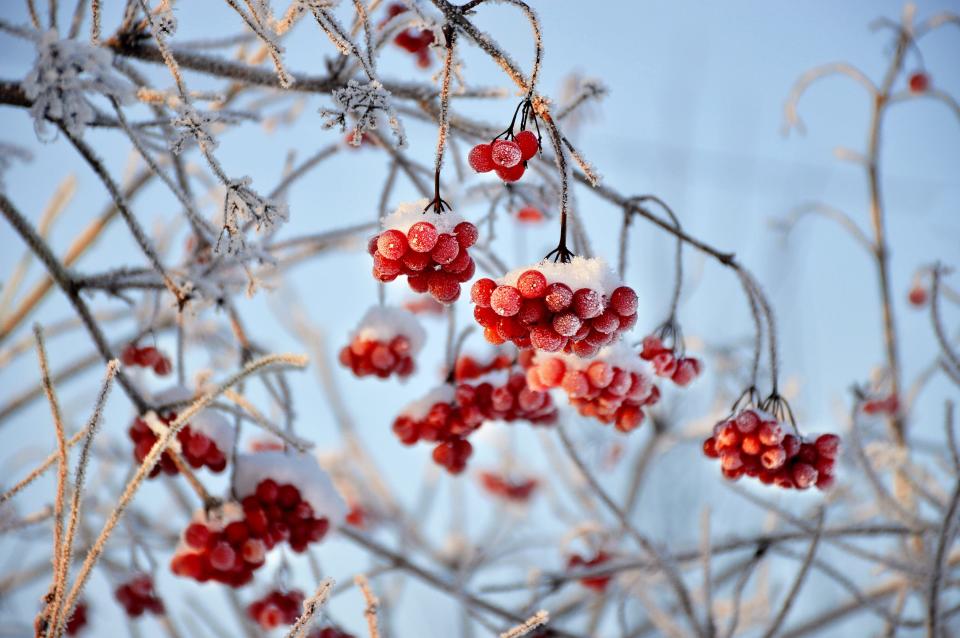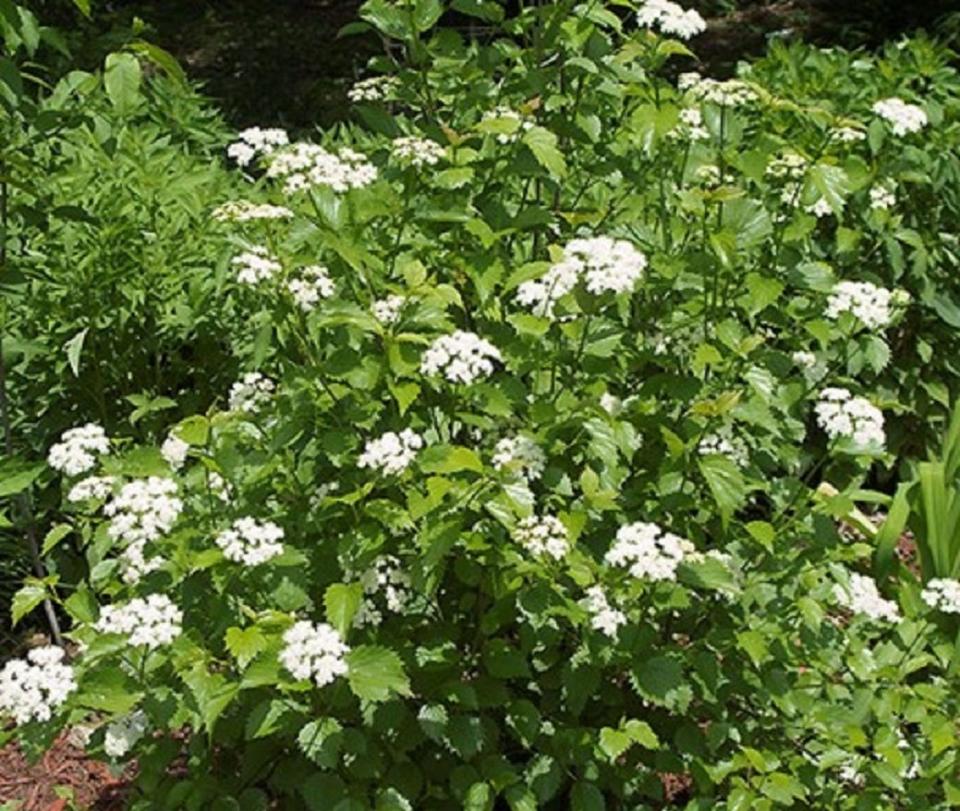There are more than 150 species and numerous cultivars of viburnums. In general, all viburnums are admired for their leaves, flowers and fruit. Most bloom in the spring. The flower color varies from white to pink and the fruit color from yellow, pink, red, blue and black. The scents of the flowers vary enormously, from the sweetest perfume to the stinkiest stench. Although some viburnums prefer dry soil, most grow in moderately fertile, moist but well-drained soil in full sun to partial shade. Their cold hardiness varies by species, but most grow in USDA Hardiness Zones 4 to 8.
Here we discuss just five viburnums, all native to New Jersey and well suited to our plant hardiness zones.
The first native species is Viburnum acerifolium, for which the common names are Mapleleaf Viburnum and Dogmackie. This shrub will grow 4 to 6 feet tall and wide at maturity. It has dark green, three-lobed leaves that are 2 to 5 inches long and resemble red maple leaves, hence the common name. The leaves turn fluorescent pink to purple grape juice in the fall. Yellowish-white flower clusters usually bloom from April to August. The flowers are followed in September by red berries that eventually turn a glossy blue-black as they ripen. Mapleleaf Viburnum is a nectar and fruit source for bees, butterflies, birds and wildlife. It is also a host plant for butterfly and moth larvae. It has limited deer resistance and low salt tolerance. It thrives best in a dry loamy, slightly acidic to neutral sandy soil, partial shade, where it has optimal light.
Viburnum dentatum, commonly known as Arrowwood or Southern Arrowwood, is another wildlife-friendly deciduous shrub. It can be found along the coast on barrier islands and in the Pinelands as it has excellent salt tolerance. It has attractive dark green leaves and the white flowers with yellow stamens provide a nectar source for native bees and butterflies. Blue-black berries follow the flowers and provide a valued food source for birds and wildlife. The Arrowwood is a host plant for Spring Azure butterfly larvae. The fall foliage can be yellow, glossy red or reddish-purple. It becomes a large, round shrub with spreading, finely curved branches. It is valued for its durability and usefulness, as it makes a good hedge or screen. It is useful for groups, crowds and barriers.

Another native deciduous shrub is Viburnum lentago, common name Nannyberry or Sheepberry, which grows as an attractive large shrub or small tree. This is a slow-growing shrub that can reach a height of 15 to 18 feet with a spread of 10 to 20 feet. It features white flowers that bloom in late spring to early summer and provide a nectar source for native bees and butterflies. In September to October the fruits ripen and change color from green to yellow, pink and pink, before maturing as bluish black. The berries provide winter food for birds. It grows best in partial shade on a dry loamy clay soil.
More: Have you been to this historic garden in Central Jersey? | Gardener stands
Viburnum prunifolium, common name Blackhaw Viburnum and Stagbush, is closely related to V. lentago as it also prefers dry feet. Blackhaw can adapt to many soil types and do best in full sun. It develops into a large, stiffly branched shrub or small tree that reaches a height of 12 to 15 feet. The Blackhaw is also very nature-friendly. The white flowers that bloom in April and May provide nectar for native bees and butterflies. The fruit is pinkish-pink and ripens to blue-black. In addition to being a good food source for birds and wildlife, the fruit is edible and used for preserves and jellies.
An interesting native, deciduous shrub with edible berries is Viburnum opulus var. Americanum (syn. Viburnum trilobum), also known as American Cranberry Bush. It is a large, coarse, rounded shrub that is quite impressive in the winter landscape. This shrub tolerates wet or swampy areas better than many plants. It prefers acidic soil and needs moisture for optimal growth, reaching 8 to 12 feet in height and width. It is often planted in landscape borders where the white, lacy flower cluster blooms in April and May, providing nectar for bees and butterflies. American Cranberrybush is an excellent choice for fruit production to feed both people and wildlife. The showy, hanging, red berries that ripen in the fall can be used for jams and jellies. The berries are also a valued food source for birds.


The list of excellent flowering viburnums is long; these are just a few select examples to consider for New Jersey landscapes. Whichever viburnum you choose for your garden, you are sure to enjoy it season after season for many years to come.
“A garden without a viburnum resembles a life without music and art.” – Michael A. Dirr, one of the great American horticulturists.
William Errickson is an agriculture and natural resources agent for the Rutgers Cooperative Extension of Monmouth County. Dennis McNamara is an agricultural program officer with the Rutgers Cooperative Extension in Monmouth County.
This article originally appeared on MyCentralJersey.com: A quick dive into viburnums | Gardener stands




